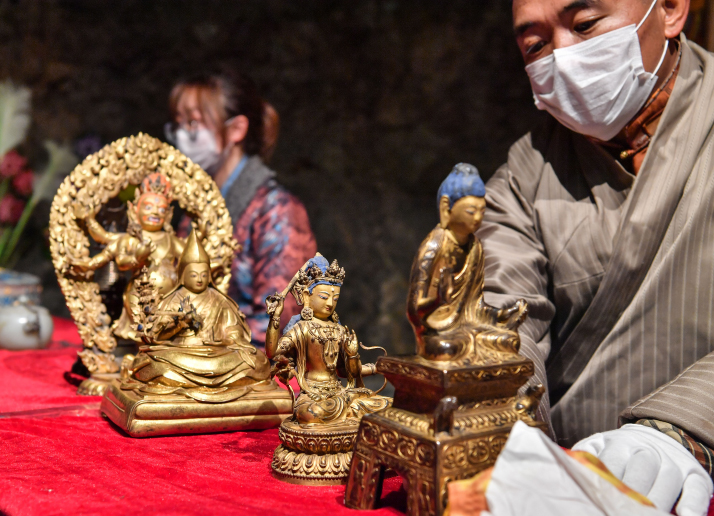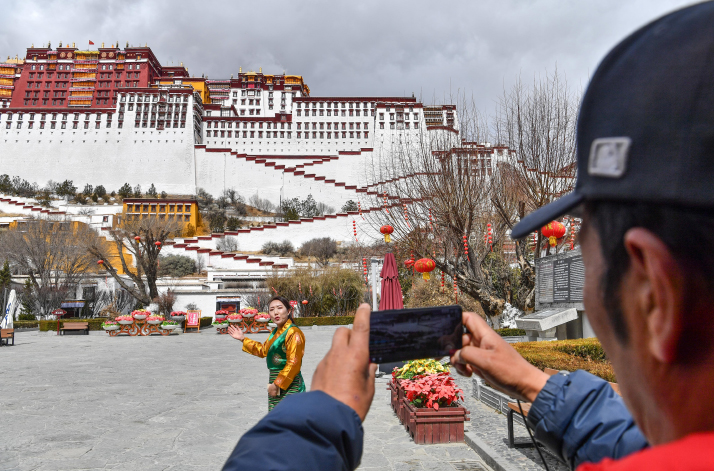| Lifestyle |
| Finding the Silver Lining | |
| The Potala Palace and other famed tourist destinations turn to livestreaming and cloud services | |
|
|
 Some priceless statues from the Potala Palace in Lhasa, Tibet Autonomous Region in southwest China, are shown in a livestreaming to provide detailed explanations to online visitors on March 9 (XINHUA)
'Dear friends, welcome to Lhasa, I'm your tour guide today," said a blithe Tsering Drolkar, bringing an aura of faraway magic with her green chuba, the long sleeveless Tibetan tunic worn by women over a blouse. The place where she was standing was even more so—the foot of the Potala Palace, one of the dream destinations of tourists all over the world and a UNESCO-recognized World Heritage Site in Tibet Autonomous Region in southwest China. The unique thing about the tour guide's introduction to the 1,300-year-old palace first built by Tibetan King Songtsa Gambo (617-650), the Tang Dynasty (618-907), was that she was not leading the usual group of tourists that day. Instead, she was speaking to the camera that was livestreaming her narration of the landmark's history to present it before the world in time of the novel coronavirus pandemic and self-isolation globally. It was the first time that the 40-hectare complex, which houses more than 130,000 priceless cultural relics, had appeared in a livestreaming. Considering public health safety during the outbreak, the Potala Palace, visited by over 1.5 million people every year, was closed since January 27. To fill the vacuum, Drolkar stepped in on March 1 with a 60-minute livestream, conducting an online tour for more than 1 million "visitors" from all over the country. Along with her, they "walked" along the classic visiting routes, enjoyed the historic sites and amazing artifacts, and learned about heritage conservation, all from the safety of their own home. As a special treat, they were taken on a tour of the Potala Palace Cultural Relics Research Office to see how ancient classics stored in the palace were being conserved and digitally preserved for future generations. They were also taken to the lofty golden roof of the palace, out of bounds for the general public. "Using digital technology to livestream the Potala Palace is a new way of making more people know more about it," said Jorden, Director of the Potala Palace Management Office. "Such interactive cloud tours enable viewers to experience the charm of the palace without leaving their home." Smart solutions In December 2019, the Alibaba Group, the Chinese multinational technology company, launched its digital tourism economy project. The objective is to boost tourism, cultural tourism and ecological partnership projects by combining actual experiences with virtual ones using the cloud platform. The online services include e-maps, shopping, food and tourism. The new venture comes after the group's involvement in the digitalization of governance, finance and retail. The outbreak of the novel coronavirus disease accelerated the launch of the smart cultural tourism industry solution. The Cloud Spring Tour, introduced on February 23, is one of the smart solutions. It focuses on online museum tours, starting with eight museums, including the National Museum of China in Beijing and the Suzhou Museum in Jiangsu Province, east China, which was designed by celebrated Chinese American architect I.M. Pei. The virtual museum tours have welcomed 10 million visitors, equivalent to the flow of visitors at the Louvre in France in one year. In addition to the livestreaming, all the online tours are recorded and saved on the cloud server so that anyone who missed them can still check them out anytime. Besides being free of charge, the service also enables visitors to vote, which collects valuable feedback for improving the service. The data generated from the e-tours can also be used for decision-making by the authorities, analyzing industry trends and collecting public opinion, which provides insight into the public demand. On March 1, away from Tibet, another livestreaming took place in Suzhou. Cheng Yi, Deputy Director of the Suzhou Museum, invited artisans specializing in Su embroidery and kesi to demonstrate the arts and their skills. Su embroidery is one of the oldest embroidery arts of China, originating in Suzhou and passed down from mothers to daughters for generations. Kesi, literally meaning cutting silk, is a traditional silk tapestry technique, where the skillful use of different colored threads gives the impression of cut threads being used in the pattern. Both are major intangible cultural heritages from Suzhou. "It is rather challenging for us to do a live show. In addition to understanding what would interest online visitors, we have to also pay attention to the interaction to deepen their understanding of traditional culture," said Jiang Han, Deputy Director of the Cultural and Creative Department of the museum. The interest generated by the livestreaming prompted a second e-tour of the Suzhou Museum about a week later with refinements. From three people, the number of people involved in the project jumped to eight, including a specialist who wrote the text. The result was gratifying with 1.25 million views and 1.15 million likes. Now the museum is planning to expand the livestream on Bilibili.com, a video website popular with young people.  A tour guide livestreams at the foot of the Potala Palace in Lhasa, Tibet Autonomous Region in southwest China, on March 1 (XINHUA)
Online meets offline The Cloud Spring Tour has been designed so that besides the online tours, people can also buy tickets to actually visit the museum, souvenirs and books. Jiang thinks the museum's creative products are not blindly copied from antiques but serve a purpose by connecting the art of the ancients with life today. In the past two years, the sale of cultural and creative products on Taobao and Tmall, two online shopping platforms owned by Alibaba, has tripled. The scale of museum-owned stores has increased six times. According to the platform's experts, the livestreamings generally can double the sales. Also, at a time when tourism products and services are facing greater competition due to their homogenization, better utilization of digital services will provide museums with core competitiveness and help them survive in difficulties like the epidemic. On March 9, the Potala Palace reappeared in another livestreaming. This time, there was a new tour guide, Dorje Phuntsok, resplendent in his traditional Tibetan clothes. Having learned from the problems faced during the first effort, this time the livestreaming was better with the signal more stable and the image clearer because of the use of 5G. In addition, six experts and scholars specializing in cultural relics joined the live lineup to provide detailed explanations for 800,000 viewers. Copyedited by Sudeshna Sarkar Comments to zhaowei@bjreview.com |
|
||||||||||||||||||||||||||||||
|
